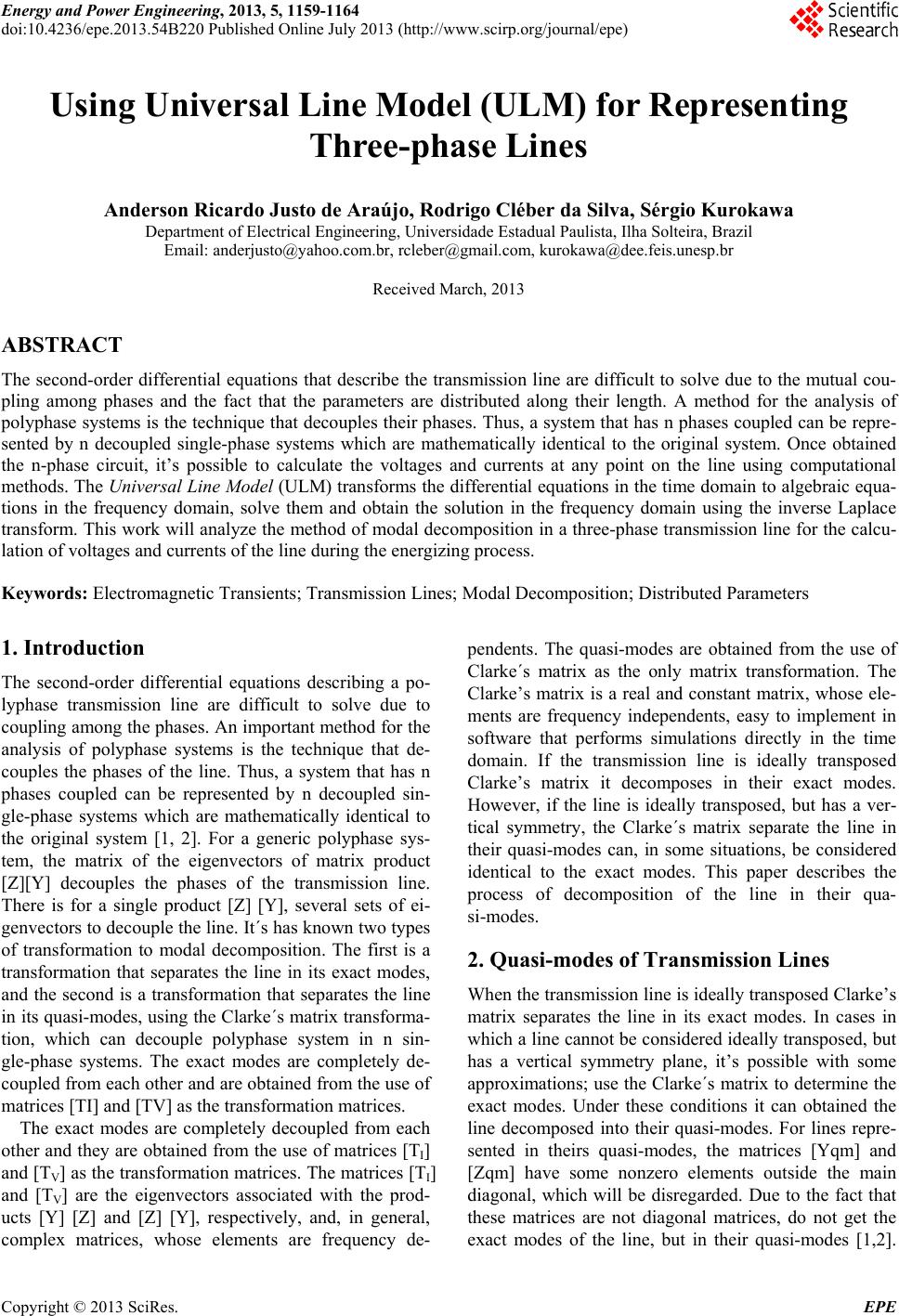
Energy and Power Engineering, 2013, 5, 1159-1164
doi:10.4236/epe.2013.54B220 Published Online July 2013 (http://www.scirp.org/journal/epe)
Using Universal Line Model (ULM) for Representing
Thr ee-phase Lines
Anderson Ricardo Justo de Araújo, Rodrigo Cléber da Silva, Sérgio Kurokawa
Department of Electrical Engineering, Universidade Estadual Paulista, Ilha Solteira, Brazil
Email: anderjusto@yahoo.com.br, rcleber@gmail.com, kurokawa@dee.feis.unesp.br
Received March, 2013
ABSTRACT
The second-order differential equations that describe the transmission line are difficult to solve due to the mutual cou-
pling among phases and the fact that the parameters are distributed along their length. A method for the analysis of
polyphase systems is the technique that decouples their phases. Thus, a system that has n phases coupled can be repre-
sented by n decoupled single-phase systems which are mathematically identical to the original system. Once obtained
the n-phase circuit, it’s possible to calculate the voltages and currents at any point on the line using computational
methods. The Universal Line Model (ULM) transforms the differential equations in the time domain to algebraic equa-
tions in the frequency domain, solve them and obtain the solution in the frequency domain using the inverse Laplace
transform. This work will analyze the method of modal decomposition in a three-phase transmission line for the calcu-
lation of voltages and currents of the line during the energizing process.
Keywords: Electromagnetic Transients; Transmission Lines; Modal Decomposition; Distributed Parameters
1. Introduction
The second-order differential equations describing a po-
lyphase transmission line are difficult to solve due to
coupling among the phases. An important method for the
analysis of polyphase systems is the technique that de-
couples the phases of the line. Thus, a system that has n
phases coupled can be represented by n decoupled sin-
gle-phase systems which are mathematically identical to
the original system [1, 2]. For a generic polyphase sys-
tem, the matrix of the eigenvectors of matrix product
[Z][Y] decouples the phases of the transmission line.
There is for a single product [Z] [Y], several sets of ei-
genvectors to decouple the line. It´s has known two types
of transformation to modal decomposition. The first is a
transformation that separates the line in its exact modes,
and the second is a transformation that separates the line
in its quasi-modes, using the Clarke´s matrix transforma-
tion, which can decouple polyphase system in n sin-
gle-phase systems. The exact modes are completely de-
coupled from each other and are obtained from the use of
matrices [TI] and [TV] as the transformation matrices.
The exact modes are completely decoupled from each
other and they are obtained from the use of matrices [TI]
and [TV] as the transformation matrices. The matrices [TI]
and [TV] are the eigenvectors associated with the prod-
ucts [Y] [Z] and [Z] [Y], respectively, and, in general,
complex matrices, whose elements are frequency de-
pendents. The quasi-modes are obtained from the use of
Clarke´s matrix as the only matrix transformation. The
Clarke’s matrix is a real and constant matrix, whose ele-
ments are frequency independents, easy to implement in
software that performs simulations directly in the time
domain. If the transmission line is ideally transposed
Clarke’s matrix it decomposes in their exact modes.
However, if the line is ideally transposed, but has a ver-
tical symmetry, the Clarke´s matrix separate the line in
their quasi-modes can, in some situations, be considered
identical to the exact modes. This paper describes the
process of decomposition of the line in their qua-
si-modes.
2. Quasi-modes of Transmission Lines
When the transmission line is ideally transposed Clarke’s
matrix separates the line in its exact modes. In cases in
which a line cannot be considered ideally transposed, but
has a vertical symmetry plane, it’s possible with some
approximations; use the Clarke´s matrix to determine the
exact modes. Under these conditions it can obtained the
line decomposed into their quasi-modes. For lines repre-
sented in theirs quasi-modes, the matrices [Yqm] and
[Zqm] have some nonzero elements outside the main
diagonal, which will be disregarded. Due to the fact that
these matrices are not diagonal matrices, do not get the
exact modes of the line, but in their quasi-modes [1,2].
Copyright © 2013 SciRes. EPE